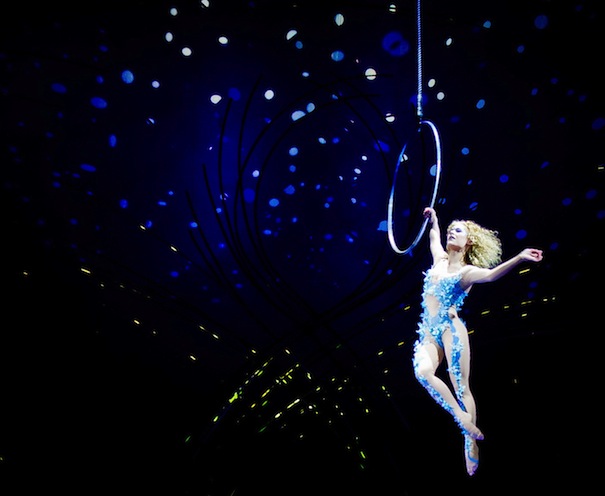Theater Review: Cirque du Soleil’s “Amaluna” — Spectacle and Sound Swamp Feminism
Women are the dominant force in “Amaluna.” They command the evening’s whirligig of a stage as aerialists, clowns, musicians, dancers, and contortionists.
Amaluna, a production of Cirque du Soleil. Artistic guidance: Guy Laliberté and Pernand Rainville. Director: Diane Paulus. At Le Grand Chapiteaux, Marine Industrial Park, Boston, MA, through July 6.
By Robert Israel
In her program note for this Cirque du Soleil extravaganza, director Diane Paulus (who is also the head of the American Repertory Theater in Cambridge) writes that: “There were two things I knew when I was asked to direct for Cirque du Soleil—that the show would be in the big top, and that it should be an homage to women….It also meant creating a story that features women characters, and here I turned to sources of inspiration from Greek mythology to Shakespeare.” Amaluna – which translates “mother moon” – achieves the first of these ambitions. Women are the dominant force here. They command the evening’s whirligig of a stage as aerialists, clowns, musicians, dancers, and contortionists, with a few male equivalents popping up from time to time. The females are statuesque, muscular, demure, radiant, mirthful, diaphanous, and beguiling. And while the men get a chance to shine, the spotlight lingers longer on the women, accentuating their collective prowess, their impressive and frequently breathtaking talents.
As for Paulus’ second ambition, tying this exquisite feminine talent to some sort of feminist inspiration, well, that’s where she misses the mark considerably.
The reason the show does not work thematically is that Cirque du Soleil is, by its self-proclaimed raison d’etre, in a class by itself, a sort of uber-theater with the accent on the visual. It may have had humble origins as an itinerant group of ragtag thespians and circus performers playing to crowds in downtown Montreal, but during its 30 year history the company has grown to become a well-oiled, highly profitable commercial enterprise, with concurrent productions now appearing throughout the States and Canada (more on this in a moment). As Robert Lepage, the brilliant Canadian director who served as the creative force behind the previous Cirque show, Ka, put it, the productions of this Quebec-based company produce “hyper-theatre, not unlike opera. Everything is larger than life: gestures, distance to be covered and the strength this all takes, not to mention the volume needed to express anything vocally…. For the artists—actors or otherwise—this requires being able to surpass oneself and a far more wide-ranging awareness.”
Paulus, who has previously demonstrated her abilities to whip up commercial theater (with a strong accent on circus/New Vaudeville) by originating shows at the Loeb theatre in Cambridge and then achieving success with them on Broadway, has never tackled something as large and free-wheeling as Cirque du Soleil. She misses the mark under the Big Top because of the sheer size and challenge of the enterprise. The tender story of a woman transitioning from a girl to a woman, which I take to be her central theme, is lost in the epic space. Actresses moving through subtle emotional transitions, from innocence to experience, are pitted against a variety of scene-stealing creatures: peacock goddesses, a moon goddess, Amazons, and a male pet named Cali (half-human, half-lizard), and many others. The notion of a young woman’s rite of passage is dwarfed by the demand for pumped-up spectacle and physical pizazz.

Miranda (Iuliia Mykhailova), the daughter of Prospera, does acrobatics around a huge water bowl. Photo: Courtesy of Cirque du Soleil
The elemental problem is that audiences that come to Cirque du Soleil expect to be wowed by “hyper-theater.” The noise level is utterly deafening: musicians rock-out with electric guitars, percussions, a saxophone, voice, an electrified violoncello, a throbbing bass. The lighting is mesmerizing, timed to highlight the feats of the players and (perhaps) to hypnotize viewers. Le Grand Chapiteaux is not so much a stage as it is a launching pad for aerialists who deftly defy gravity by leaping, somersaulting, and bounding into the air above our heads. It is a place where a larger-than-life water bowl is rolled out, center stage, so that Iuliia Mykhailova, a gifted contortionist/dancer/acrobat can swim and then emerge, dripping wet, to perform feats upside down, using only the strength of her arms. And throughout all of the highly-controlled, eye-popping mayhem, we’re supposed to follow Paulus’ feminist/mythic theme through its many incarnations?
Cirque du Soleil’s business model shapes its creative product: consider this bit of analysis about the troupe’s tremendous success in an article that appeared in the Harvard Business Review a few years ago: “Its value innovated by shifting the buyer group from children (end-users of the traditional circus) to adults (purchasers of the traditional circus), drawing upon the distinctive strengths of other alternative industries, such as the theatre, Broadway shows and the opera, to offer a totally new set of utilities to more mature and higher spending customers.” You could argue that Cirque du Soleil’s approach has become a model for (too) much stage work today — the theatrical imagination is contorted to fit demographic/business strategies.
Cirque du Soleil may be a victim of its own unbridled success, expanding too fast. Concurrently, the franchise has a production that just premiered in Montreal and is slated to travel to Toronto in August. It has another show at Disney World in Florida. And it is running a boffo third production, celebrating the life and music of Michael Jackson, in Las Vegas. The show in Boston is underwhelming. It has its moments of razzle-dazzle. But the story – the dramatic vehicle that supposedly ties all of Amaluna together — ends up on the dark side of the moon.
Joann Green Breuer’s review of the Montreal premiere of Amaluna for The Arts Fuse.
Robert Israel writes about theater, travel and the arts, and is a member of Independent Reviewers of New England (IRNE). He can be reached at risrael_97@yahoo.com

